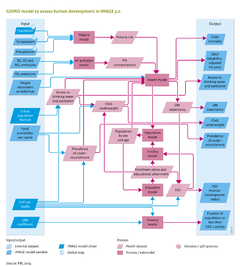Human development: Difference between revisions
Jump to navigation
Jump to search
No edit summary |
No edit summary |
||
| Line 9: | Line 9: | ||
The Global Integrated Sustainability Model ([[GISMO model|GISMO]]) addresses (changes in) human development, including its distribution, improvement and continuation, as a result of changes in the three underlying sustainability domains, i.e. economic, social and environmental ([[Hilderink and Lucas, 2008]]). Among others, the model quantifies human development in terms of access to food, water and energy, the Human Development Index (HDI), Population Health measures (such as child mortality and life expectancy), and many indicators of the Millennium Development Goals (MDGs). | The Global Integrated Sustainability Model ([[GISMO model|GISMO]]) addresses (changes in) human development, including its distribution, improvement and continuation, as a result of changes in the three underlying sustainability domains, i.e. economic, social and environmental ([[Hilderink and Lucas, 2008]]). Among others, the model quantifies human development in terms of access to food, water and energy, the Human Development Index (HDI), Population Health measures (such as child mortality and life expectancy), and many indicators of the Millennium Development Goals (MDGs). | ||
Here we concentrate on those parts of | Here we concentrate on those parts of GISMO that link directly to other parts of the IMAGE core model: climate related health risks, urban and indoor air pollution related health problems, and effects of malnutrition. On all scale levels, from global UN processes to local initiatives, decision makers are concerned with improving the standards of living and human development. The IMAGE framework provides valuable insights in key environmental factors that affect human development, and how these impacts can be reduced as the result of improvements in the state of the natural environment | ||
}} | }} | ||
Revision as of 12:06, 2 August 2013
Parts of Human development
| Component is implemented in: |
|
| Related IMAGE components |
| Projects/Applications |
| Models/Databases |
| Key publications |
Key policy issues
- What are the key future trends in human development, such as those targeted by the Millennium Development Goals (MDGs)?
- How are changes in the global environment likely to affect human development?
- How is improved access to food, water and energy likely to contribute to human development?
